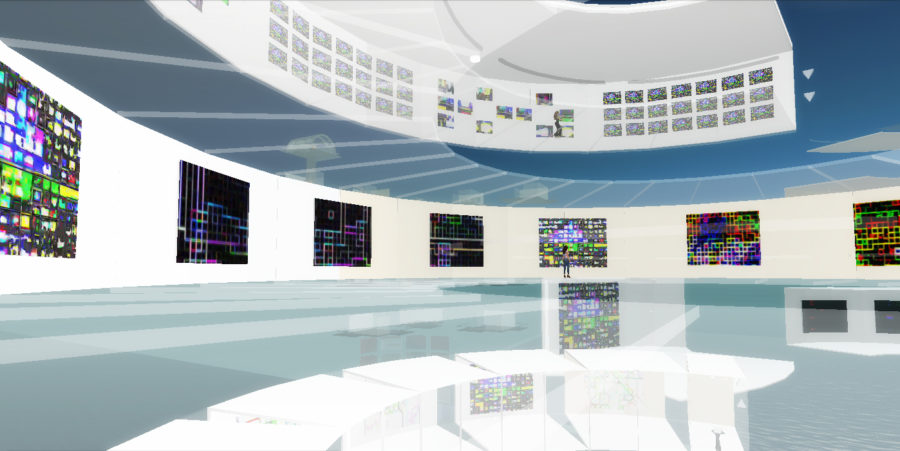A guide to navigating the metaverse
Kyle Kondas
Kyle Kondas, an Arts & Technology student at the University of Texas at Dallas, held a gallery showing in the Metaverse Gallery on the Arts & Technology Island.
February 1, 2022
We haven’t fully accepted the idea of a metaverse, yet it’s already being commercialized to increase milk production. How? On Jan. 6, Turkish farmer Izzet Kocak placed his cows in a metaverse to trick them into thinking they were grazing in green summer pastures when, in reality, they were cooped up in small cages.
With open grassy fields and cow-sized virtual reality (VR) goggles, the cow’s anxiety levels declined and they produced more milk than usual. The somewhat disturbing experiment was so successful that more farmers are looking to do the same thing to their cows.
Okay, I admit, that’s probably not what you were expecting to read about when opening an article about the ‘metaverse’. But hear me out. Even though forcing cows into a metaverse feels as though we’re the perpetrators of a new “Matrix” where one species places another into a controlled environment that capitalizes on the other’s energy—er, milk—this weird example goes to show just how influential the metaverse could be in ways we’ve never imagined before.
What the metaverse is
The concept of the metaverse was first coined by Author Neal Stephenson who, in his 1992 cyberpunk novel “Snow Crash,” wrote of a world where people used digital avatars to meet in realistic virtual reality environments to escape a dystopian reality.
Since then, Ernest Cline’s 2011 novel-turned-film “Ready Player One” and Shawn Levy’s “Free Guy” brought the concept of the metaverse to cinemas, enabling people to envision the transformative potential of a gaming metaverse. The films displayed characters such as Wade Watts and Guy who undergo challenges to liberate the Oasis and Free City (the movie’s metaverses) from CEO antagonists.
The meaning of the term ‘metaverse’ is often debated, but it broadly refers to a virtual universe where everyone can exist as digital avatars and interact with one another and with the universe around them. People can interact with the metaverse while utilizing technologies such as VR and augmented reality (AR).
Well-known venture-capitalist Matthew Ball described the metaverse as “an expansive network of persistent, real-time rendered 3D worlds and simulations… can be experienced by an unlimited number of people at the same time, in which everyone will have their own sense of presence.”
For example, video games such as “Fortnite”, “Roblox “and even “Animal Crossing: New Horizons” have shown metaverse-like elements because they all have shared, online spaces where users can interact with one another within their virtual gaming worlds.
How companies are getting involved
The idea of the metaverse isn’t as futuristic as it sounds. Microsoft announced on Jan. 18 that it will advance its metaverse plans by merging with Activision Blizzard, the gaming company that developed games such as Call of Duty and World of Warcraft, for $69 billion, which is the highest price ever paid by a U.S. tech company in an acquisition.
Apart from video games, Facebook, which owns platforms such as Instagram and WhatsApp, announced it was rebranding itself as Meta Platforms to signify its interest in building its own metaverse platform where anyone can “get together with friends and family, work, learn, play, shop [and] create,” CEO Mark Zuckerberg wrote in a founder’s letter. To do this, Meta is developing the world’s fastest AI supercomputer to power the metaverse.
On Jan. 27, Apple CEO Tim Cook teased his metaverse ambitions by discussing the expansion of Apple’s augmented reality apps, causing Apple’s stock price to jump 5% after-hours following an 8-day losing streak.
It’s not only big technology companies getting involved. Startups are also innovating technologies to assist users in the metaverse. For example, Emerge launched the Emerge Home system on Jan 28. The system emits sculpted ultrasonic waves that allow users to feel and touch with their bare hands as controllers.
Additionally, Walmart filed trademark applications on Jan. 16 with plans to create its own virtual currency and sell goods within the metaverse, potentially offering a way for shoppers to buy products in a virtual Walmart supermarket that can then be shipped to homes.
But not all products sold have to exist in real life. Nike filed trademark applications to develop branded clothing apparel that can be used by digital avatars in the metaverse. They also purchased virtual sneaker creator RTFKT and are developing a virtual world known as ‘Nikeland’.
Metaverse of tomorrow
What would a complete metaverse look like in the future? The short answer is that no one truly knows; we can only speculate. Just as it was hard to envision in 1982 what the internet of 2022 would be like, tech analysts find it hard to describe the metaverse.
Maybe the metaverse could ultimately be a place where anything physically possible in reality can be performed in a virtual reality environment, similar to the artificial Earth depicted in the movie “The Matrix.”
Maybe the metaverse could be centered on a solo perspective limited only by your imagination, where you can be an Avenger superhero, travel back in time to live in ancient Egypt or even rule over an alien planet, all without ever leaving your room.
Or maybe the metaverse could be documenting humanity’s most cherished traits and memories, preserving our species forever within an accessible digital footprint, similar to concepts embedded within James Cameron’s “Avatar,” Lois Lowry’s “The Giver” and the animated series “Cowboy Bebop”. Whatever the case, what exists today is nowhere near the potential for the future of the metaverse.
How to get there
For a few years, investors have been pouring into Ethereum-based metaverse platforms (blockchain metaverses built on Ethereum) such as Decentraland and Sandbox, hoping to invest in the metaverse before it becomes too expensive for the average investor. Experts predicting our lives to be fully immersed in the metaverse by the year 2030 have only accelerated the craze.
In fact, interest in digital ownership of the metaverse has spiked dramatically. When celebrity rapper Snoop Dogg bought up land in the virtual world Sandbox for half a million dollars with plans to develop the land known as “Snoopverse,” digital land prices in neighboring areas on the Sandbox map skyrocketed.
Unfortunately, if you were to try these platforms today, you’d be shocked at how underdeveloped the graphics, software and technology is, compared to, for example, Sony’s Playstation games. Indeed, investment into the metaverse may not have gained as much traction as it should have because some investors have been scared away by the 90s-esque video game quality of the platforms.
The poor quality has been a rallying cry for doubters about the potential for development of the metaverse. Some claim the metaverse can never have graphics that mimic the real world as long as users are limited by the internet speeds we have today. Recently, however, those doubts have been washed away with the introduction of 5G networks that could solve slow connection speeds and high latency problems by being 20 times faster than previous internet speeds.
Critics have also found the Ethereum-based metaverse platforms to be very similar to existing video games such as Roblox and Minecraft. The only differences? Real-world applications and a cryptocurrency standard you can use within the platforms as real money. The differences are game changers for users because using virtual currencies within the metaverse that are accepted when paying for real-life goods can help connect the metaverse closer to our daily lives.
Moreover, there’s still much to do if we want a metaverse where you can do ‘anything in a virtual reality environment’. For one, we need AI software that lets you integrate your own ideas into the metaverse rather than standard business conferencing or standard clothes/housing to buy from. Granted, we’re a long way from developing the capabilities to integrate AI into the metaverse, but user created content could still prove important in making the metaverse experience more personalized and intriguing.
Additionally, we need a single decentralized metaverse to make the metaverse space more like the general internet rather than multiple metaverse platforms that are controlled by different companies.
In fact, Ball argued that the metaverse should offer “unprecedented interoperability,” or in other words, users should be able to seamlessly move their avatars and items from one place to another, no matter who runs that particular part of the metaverse. That way, metaverse users would be able to truly interact with one another in ways, such as buying and selling non-fungible tokens (NFTs) or using cryptocurrency like we use paper money today with quick transactions and almost no fees.
Universal interoperability would enable users to trade goods and services in the metaverse as fast as it would hand-to-hand in the real world. You might theoretically be able to bid at a high-end auction of famous NFT memes, then attend a live Jay-Z concert at a different location in the metaverse without having to switch applications or software.
Because they don’t offer universal interoperability, Meta and Microsoft’s new ideas and the Ethereum-based metaverses aren’t true metaverse concepts but are instead interactive platforms that fit into the same internet structure we’ve seen for the past 30 years.
Since the big technology companies haven’t done it yet, I’m sure you’re wondering: is a metaverse with universal interoperability even possible? Epic Games CEO Tim Sweeney thinks so. He sees the metaverse as an extension of elements found within the popular video-game Fortnite, and he wants to use it to break free of the current “walled garden” online model dominated by technology giants such as Google, Facebook and Apple.
The technology is certainly there; NFTs, blockchain and cryptocurrencies such as Ethereum are being employed to help the current metaverse platforms function. However not all metaverses offer NFTs and some metaverses use cryptocurrencies and blockchain technologies that lack interoperability.
Benj Edwards, associate editor for How-to-Geek puts it clearly—“The fundamental technologies that would let people chat, own property, and do business across platforms and devices in a 3D virtual world have not been standardized in a way that makes it possible. To make it happen, it will take widely-adopted communication protocols that don’t exist and reinterpretation of intellectual property law.”
In the past, when new industries emerged, such as search engines, VCRs and HDTVs, there were competing models at first, but ultimately the market solidified around a winning contender that became a standard for the particular industry. In this case, the winning contender need not be a monopoly but instead an agreement to make the metaverse decentralized and shared. Hopefully then we will see widespread adoption, fewer legal barriers and the spark of a true metaverse.
Concerns with the future
You might be wondering: what happens when we fully succumb to an artificial lifestyle instead of living our lives in the real world? Well, nothing really. Because at that point, the metaverse would be our new lives anyways.
Take “Ready Player One” for example. The film’s main protagonist Wade Watts explains that after suffering droughts and riots before the year 2045, “people stopped trying to fix problems and just tried to outlive them.” They decided to spend as much time as possible in the metaverse known as the Oasis. But instead of the plot being about saving humanity from the Oasis, the plot was about saving the Oasis from the antagonist of the movie, CEO Nolan Sorrento.
Just as the introduction of the internet and first smartphones received backlash from individuals who were repulsed by the changes to their daily lives, the metaverse will continue to face similar scrutiny. But in the end, the overall transformative benefits of the metaverse for all users outweigh the harm of potential overuse.
If succumbing to the metaverse is acceptable, then how much time should people spend in the metaverse? As long as you can do everything you can in the real world, interact with everyone you wish, and learn and develop just as you would in real life, you should be able to spend a majority of your time in the metaverse. Granted, people still need time to take care of themselves, eat food, drink water and sleep but any time you would’ve spent at school, working or shopping could instead be done in new ways.







